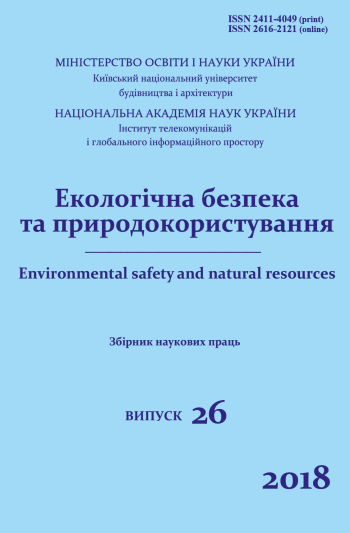Creation of energy efficient "green constructions" in conditions of moderately continental climate
DOI:
https://doi.org/10.32347/2411-4049.2018.2.77-84Keywords:
green structures, green roofs, adaptive potential, assortment of plants, layered designAbstract
The main aspects of creation of energy-efficient «green structures» in urbocenoses of moderate-continental climate are considered. It was established that problems of exploitation of "green roofs" arise in case of violation of the technology of laying roofing layers and in case of incorrect selection of plant assortment. Technical problems in creating "green roofs" arise when the wrong choice of waterproofing. There should also be a single drainage system, which accommodates all other elements. Failure to observe these conditions may lead to rooting and the development of microorganisms. The assortment of plants on an intensive roof is usually limited to low-growing plants: herbs, shrubs and shrubs. Phenological observations carried out on the intensive roof of the Royal Tower residential complex in Kyiv have shown that with the correct selection of plant assortments and their cultivation technology, plant height can be considerably larger: from 4 to 6 m, which significantly expands the ecological and biological capabilities of intensive green roofs moderately-continental climate. The assortment of species of plants with high adaptive potential of various life forms with a wide variation of height is proposed: from low-growing herbs to trees of 6 m in height: Quercus paludosus multicaulus, Quercus rubra multicaulus, Pinus sylvestris, Acer rubrum, Acer rubrum 'Scanlon', Chenomeles Maulei, Arónia melanocárpa, Berberis thunbergii, Betula pumila, Crataegus laevigata, Vitis amurensis, Parthenocíssus tricuspidáta, Cornus alba, Picea abies, Picea сanadensis, Picea pungens, Lonicera alpigena, Lonicera caerulea, Salix caprea, Viburnum opulus, Cotoneaster lucidus, Acer tataricum, Acer ginnala, Elaeagnus argentea, Juniperus horizontalis, Juniperus sabina, Sorbus aucuparia, Ribes aureum, Symphoricarpos albus, Pinus mugo, Spiraea arguta, Spiraea japonica, Thuja occidentalis, Philadelphus coronaries, Mālus sibirica, Malus niedzwetzkyana.References
Tehnoekologija: navch.posib. dlja vyshh. navch. zakl. / V.M. Udod, V.V. Trofimovich, O.S. Voloshkina, O.M. Trofymchuk. – Kyi'v: KNUBA, ITGIP NANU, 2007. – 195 s. (in Ukrainian)
Landshaftna ekologija: navch. posibnyk / A.Je. Kuskov, T.M. Tkachenko. – Makii'vka, Donec'k: vyd-vo Noulidzh, 2009. – 165 s. (in Ukrainian)
Tkachenko T.N. Vozmozhnost' sozdanija jenergojeffektivnyh jekologicheski chistyh zelenyh tehnologij v uslovijah Ukrainy // Stroitel'stvo, materialovedenie, mashinostroenie: sb. nauchn. trudov. Serija: «Sozdanie vysokotehnologicheskih jekokompleksov v Ukraine na osnove koncepcii sbalansirovannogo (ustojchivogo) razvitija, Vyp.81, GVUZ «Pridneprovskaja gosudarstvennaja akademija stroitel'stva i arhitektury». – Dnepropetrovsk, 2015. – S. 256–260. (in Russian)
Grant, G., L. Engleback, B. Nicholson, D. Gedge, M. Frith, and P. Harvey. 2003. (in English)
Brenneisen, S. 2003. The Benefits of Biodiversity from Green Roofs Key Design Consequences. In Proc. Greening Rooftops for Sustainable Communities: Chicago 2003.
Sutton R.K. Green Roof Ecosystems. – Cham: Springer, 2015. – 447 p.
Izumi C. Mori. Biomarkers of green roof vegetation: anthocyanin and chlorophyll as stress marker pigments for plant stresses of roof environments / C. Mori Izumi, S. Utsugi, S. Tanakamaru, A. Tani, T. Enomoto, M. Katsuhara // J. Environ. Eng. Manage., 19(1), 21-27 (2009)
Peck Steven W. Report on benefits, barriers and opportunities for green roof and vertical garden technology diffusion / Steven W. Peck, Callaghan C., M. E. Kuhn, B. Bass – Canada Mortgage and Housing Corporation, 1999. – 77 p.
Minke whales, G. und Witter, G.; Haeuser mit Gruenem Pelz, Ein Handbuch zur Hausbegruenung; Verlag Dieter Fricke GmbH, Frankfurt, 1982.
Metody opredelenija morozostojkosti rastenij. / Pod red. Tumanova I.I. – M.: «Nauka», 1967. – 88 s. (in Russian)
Nojferta P., Nefa L. Proektirovanie i stroitel's'vo. Dom, kvartira, sad. – M.: Arhitektura-S, 2005. – 255 s. (in Russian)
Ljusev V.K. Posobie po ozeleneniju i blagoustrojstvu jekspluatiruemyh krysh zhilyh i obshhestvennyh zdanij, podzemnyh i polupodzemnyh garazhej, ob#ektov grazhdanskoj oborony i drugih sooruzhenij. – M.: Strojizdat, 2008. – 110 s. (in Russian)
Tkachenko T.N. Al'ternativnye vidy promyshlennogo ozelenenija / Tkachenko T.N., Savenkova S.V. // Naukovo-tehnichne ta organizacijno-ekonomichne spryjattja reform u budivnyctvi i zhytlovo-komunal'nomu gospodarstvi: tez. III mizhnar. konf. (12.04-13.04.2012) / Makii'vka, Donbas'ka nacional'na akademija budivnyctva i arhitektury. – 2012. – Ch.I. – S. 211–214. (in Ukrainian)
Downloads
Published
How to Cite
Issue
Section
License
Copyright (c) 2019 T.M. Tkachenko

This work is licensed under a Creative Commons Attribution 4.0 International License.
The journal «Environmental safety and natural resources» works under Creative Commons Attribution 4.0 International (CC BY 4.0).
The licensing policy is compatible with the overwhelming majority of open access and archiving policies.

